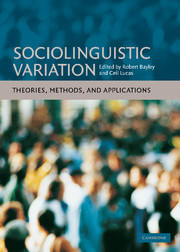Book contents
- Frontmatter
- Contents
- 1 List of figures
- 2 List of tables
- Acknowledgments
- Notes on editors and contributors
- Introduction
- Part 1 THEORIES
- 1 Variation and phonological theory
- 2 Syntactic variation
- 3 The psycholinguistic unity of inherent variability: old Occam whips out his razor
- 4 The study of variation in historical perspective
- 5 Style in dialogue: Bakhtin and sociolinguistic theory
- 6 Variation and historical linguistics
- 7 Second language acquisition: a variationist perspective
- 8 Variation and modality
- Part 2 METHODS
- Part 3 APPLICATIONS
- Afterword: Walt Wolfram and the study of sociolinguistic variation
- References
- Index
6 - Variation and historical linguistics
Published online by Cambridge University Press: 16 February 2010
- Frontmatter
- Contents
- 1 List of figures
- 2 List of tables
- Acknowledgments
- Notes on editors and contributors
- Introduction
- Part 1 THEORIES
- 1 Variation and phonological theory
- 2 Syntactic variation
- 3 The psycholinguistic unity of inherent variability: old Occam whips out his razor
- 4 The study of variation in historical perspective
- 5 Style in dialogue: Bakhtin and sociolinguistic theory
- 6 Variation and historical linguistics
- 7 Second language acquisition: a variationist perspective
- 8 Variation and modality
- Part 2 METHODS
- Part 3 APPLICATIONS
- Afterword: Walt Wolfram and the study of sociolinguistic variation
- References
- Index
Summary
Introduction
When Ferdinand de Saussure outlined his celebrated distinction between synchrony and diachrony in what became his Cours de linguistique générale, he stated that “the opposition between the two viewpoints … is absolute and allows no compromise. A few facts show what the difference is and why it is irreducible” (1916[1959]:83). Nearly a century later, linguistic scholarship has considerably united the two perspectives on language and resolved, one must hope, Saussure's quandary about how the linguistic present and the linguistic past inform one another. Because it is socially situated and motivated, variation is intrinsic to natural language and is always potentially unstable. It follows then that by comparing variation between two or more points one can detect and measure change. Historical linguistics and the study of language change have been inconceivable without an awareness of language variation.
Today those who explore the evolution of language through tracking variation have far more diverse tools than ever before. Traditional philological methods for assessing and interpreting written texts have a rich tradition for analyzing pronunciation and grammar from which many trained in modern speech-based linguistics can learn. Over the past forty years sociolinguistic concepts and quantitative methods have been applied to language change and variation, producing increasingly sophisticated explorations. Cross-generational analysis of change in progress, based on the construct of “apparent time” (Bailey 2002), posits that historical change is observable by comparing contemporary age cohorts, that in essence synchrony can be converted to diachrony. The scholarship of social historians (e.g. on migration) has made possible better informed study of the ecological scenarios in which linguistic variation and change take place.
- Type
- Chapter
- Information
- Sociolinguistic VariationTheories, Methods, and Applications, pp. 110 - 132Publisher: Cambridge University PressPrint publication year: 2007
- 3
- Cited by



